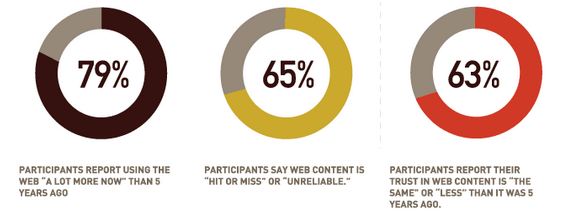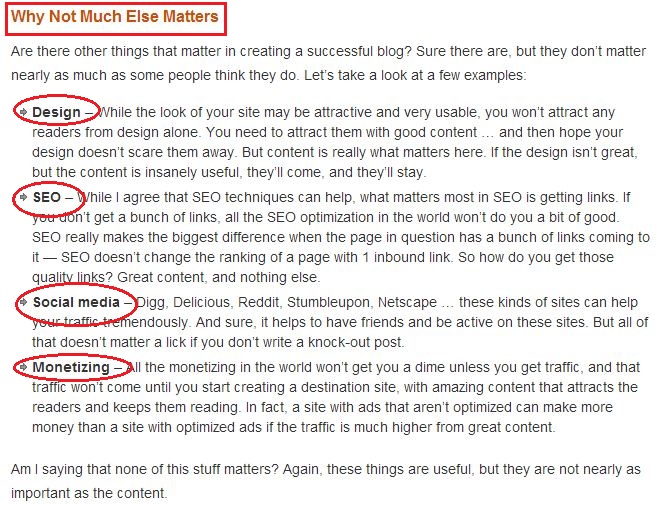Importance of Content Audits for Content Marketing Success
Last Edited June 8, 2016 by Garenne Bigby in Content Audit

For years now content has been king of the marketing game. After all, rock solid content is what keeps your visitors on the page and wanting more, right? Great content is what makes visitors turn into conversions, with a little help from search engine optimization, and both XML and HTML sitemaps. But writing really good content that converts takes time, a lot of energy and research, doesn’t it?
So, how do you produce high quality content that converts?
Every single content marketer out there has their own way of creating high quality content, but there are quite a few things that you should consider before diving into the writing process. The last thing you want to do is backtrack and rewrite content that is not fully developed. While it’s true that writing website content is very different than writing fiction, every piece of content that is created should be researched and developed in order for it to be the best it can be.
For example, before you dive into writing a slew of content it is very important for you to identify your audience and what they want. You can’t just write anything and expect your demographics to come to your website—you want to create content that is written for your audience. You want your content to resonate with your audience so that they will come back and/or share.
While you might not be someone who wants to spend hours on learning about your audience, it doesn’t hurt to ask for feedback from your readers or current customers, through surveys or via your social media pages. You can also take a little bit of time to review case studies in your industry and niche, learning what your competitors have published.
For example, what is your general demographic and what or who influences them? What is your audience looking for? What do they need? All of these questions should be answered before you start your writing process to ensure that your content will be as relevant [to your audience] as possible. After you have done this, you will be ready to proceed with the first step of creating high quality content.
Now, like it or not, it’s almost impossible to write high quality content unless that content is well researched and supported. You will want to identify and develop your topic, review what’s already been talked about and identify any gaps in content so that you can say what hasn’t already been said.
Write, take inventory and audit your content for success.
No matter what your online business is, what product you’re trying to sell or what you’re writing about, right out of the gate you should know that writing for the web is not like writing a school essay or term paper. Avoid the bore, keep it entertaining and engaging. If you make your content too technical you will likely deter a lot of visitors and they will go somewhere else.
In addition to the above, writing content that creates credibility is very important. Anyone can write anything they want on the internet, which is why 65% of website readers find content to be hit or miss or unreliable, according to a recent study performed by Content Science, a content strategy company. That said, if you’re wanting to be taken seriously you will need to qualify yourself with your content and create credibility.
Check out the image below, showing the results of the study (mentioned above). 79% of participants reported using the web a lot more now than they did years ago, 65% of participants say website content is hit or miss or unreliable and 63% of participants report their trust in web content is the same or less than it was five years ago.

So what do you do if you want to build your credibility from the moment you step out of the gate? You write unbiased and non-promotional content. Self-promotion can work when you’re seen as reliable and reputable, but the last thing you want to do is sound like you’re just trying to sell, sell, sell because the truth is that if people wanted to hear more about your products and services, they would have just referred to your ads. SHOW THEM that you’re credible, that you know what you’re talking about through the use of high quality content. Web readers are hypersensitive to brands trying to sell something or endorse a product.
You can also boost your credibility in a variety of other ways such as qualifying your experience or expertise, linking to other industry experts so that your readers have a lot of resources to check out and use attribution phrases whenever possible.
Creating Useful Content
Useful content is a must—your readers or visitors will not take the time to read a bunch of random content that doesn’t mean anything. It should also be unique. And while it is also necessary to optimize your content with keywords, don’t overstuff your content because it will do more harm than good.
Back in the day, SEO tactics including stuffing content with as many SEO keywords as possible to manipulate a website’s page ranking in Google’s SERP. Sites could rank on a large variety of keywords by simply cluttering them onto a page, even if the keywords were unrelated and the site was absent of any real content.
That was then, this is now, and a positive user experience is just as important as high quality content. And most people aren’t going to go looking for a website that just reads “discount camera goods” 500 times in a row. Google and other search engines have wised up and filters out offending keyword-stuffed pages, because these pages are largely devoid of useful content.
The nature of the internet lends itself to website readers hunting for solutions and actionable content that they can use. So your content needs to provide readers and website visitors with something solid and concrete, something they can rely on. When you start writing your content think about what you want your readers to think, feel or do? You should also think about what you want to talk about and what your main points are.
In addition to creating useful content, you want to write in a tone that will keep your readers engaged—a conversational style with standard grammar and spelling. While corporate or executive websites and blogs will use a more business-professional voice, most websites should utilize an informal tone, without overdoing the informal language. You don’t want to throw out grammatical rules—grammar and spelling still matters.
Structuring Content for Readers and Search Engines is a Must
As mentioned earlier in this article, avoiding the traditional essay format is important. The last thing we want as a content marketer or website is long blocks of text. Not only will it look horrendous, it will be ineffective especially since humans tend to scan instead of read website content.
A good rule of thumb for top notch website content is to:
-
Use short paragraphs (between 1-4 sentences is a good range to aim for)
-
Bullet point lists are much easier to read and scan than are traditional essay articles
-
Use bold or italics to emphasize points
-
Use subheadings to guide your readers through the article. Readers should be able to skim subheadings to get an idea of what your main points are
-
Get to the point; don’t include a lot of fluff and useless content
-
Keep your main points front and center (for example, make each main point a subheading or bolded)
-
Keep your content long enough to thoroughly cover the subject, but don’t drag it out (hint: if you feel like you’re done writing, you probably are)
-
Use images and visual examples to give your reader a “visual break”
All of the above works wonderfully with creating optimized content as well. Using a heading, subheading, bolded words and italics is important.
The following image talks about what scannable content means for your website:
Scannable Content:

If you keep all of the above guidelines into consideration when you begin writing your content, you’ll be many steps ahead of the game. Ahead of those content marketers or website owners who started writing and publishing their content way before they should have, before their content was properly researched and tailored to their select audience.
The next step of the game is performing an inventory and audit of your content, ensuring it’s the best it can be for search engines and for your readers.
Performing a Content Audit for Success
Before we really get into discussing content audits, I should briefly discuss the prerequisite of an audit: a content inventory. A content inventory is kind of like taking inventory of produce or goods in a grocery store, except it’s dealing with all of your website content including all text, images, documents and applications. To gain a true understanding from your content inventory you will need to assess each piece of content on your website to make sure it’s in the proper location and up to date—all of which is imperative.
As you can probably imagine, content inventories can get quite massive, especially for websites that are information-rich (i.e. blogs). Compiling your inventory on a spreadsheet will allow you to sort and filter through the data with ease. However, it’s important to keep in mind that this can be very time consuming—another reason why utilizing a sitemap generator would be beneficial.
While content inventories do tend to vary in what they capture, they often include the following data for each piece of website content:
-
Unique Content ID
-
Description (the title of the content item)
-
URL
-
Format (HTML, PDF, DOC, etc. Hard copy, electronic file and links)
-
Author or Provider
-
Physical location (in the content management system, on the server, etc.)
-
Meta Description
-
Meta Keywords
-
Categories/ Tags
-
Dates (created, revised, accessed)
-
General Notes
After you’ve completed your content inventory you will be ready to turn that inventory into a significant content audit, one that will help to transform your website and its success. It is recommended that you perform an assessment of the raw data the content inventory provided you with. This assessment will vary from user to user depending on what you’re hoping to learn.
Upon completion of your assessment, you can choose what kind of content audit makes the most sense for you and your website needs. It’s common for audits to track what website pages should be removed, whether the content within the website should be revised or revamped, and what website content should be written or added to your website in order to fill in the gaps. Furthermore, a content audit will help you track and understand where content should be mapped to if it’s being moved or redirected.
A content audit is imperative to the success of content marketing campaign, SEO strategy and your website’s maintenance as a whole, regardless of how established or new your website is. For newer websites, a content audit will help you understand what it will take to compete in your market, what market opportunities you might have and it will allow you to truly understand the importance of blog and high-quality content, especially when it comes to your success. After all, companies that have incorporated a blog into their website get 55% more web traffic than those that don’t.
Existing websites will have the ability to learn about the health status of their online presence to ensure that their website is optimized at code level and content level. Additionally, website owners of an existing site will learn what inbound links may be necessary for success, find more unique and quality keywords within the market and improve on social media presence.
Keeping all of this into consideration, there’s really not one correct approach to conducting a content audit. That said, the exact steps that a website owner takes will depend on their reason for undergoing an audit in the first place. With that said, it’s typical for content audits to be conducted for two primary reasons including:
-
SEO Purposes. Conducting a content audit for SEO purposes will help you identify any weak spots in your website’s SEO. For instance, by labeling word count, different tags, optimized images and other elements associated with your website content and comparing those elements to your current page rank, you will be able to determine what kind of changes need to happen in order to improve your website’s natural search performance. Thus, boosting yourwebsite’s performance considerably.
-
Content Marketing. Content marketing is a big deal for small to large businesses, ecommerce websites and basically any other website that is looking to surpass their competitors in the search engines (i.e. everyone). A content audit will help you assess the current status of your content marketing efforts so that you can work to improve on those efforts. Instead of looking at page optimization factors, you will want to concentrate on things like page length, visit metrics and social shares in order to determine how your audience is responding to your content and consequently, how you should alter your content marketing efforts from there on out.
Now, a good content audit can be a very time consuming process without utilizing a content inventory tool like DYNO Mapper. Without a proper software you will find that the undertaking of a content audit will be quite massive, taking a lot of time and energy. There are other options, however, such as utilizing an outsourced worker through various outsourcing websites such as Upwork, Guru or Elance, but a content inventory tool is likely to be much more cost-efficient in the long run as you will need to complete content audits in the future.
As you can see, it’s almost impossible to have a successful content marketing strategy without high quality content. And while your website can have top notch website content without a content inventory and audit, these tools will help to ensure that everything is as it should be—if not better. Furthermore, if you perform a content inventory and audit on a regular basis you could literally watch your website surpass any competitors, ranking high in search engines.
Related Articles
- 33 Amazing Content Audit Tools for Easy Content Analysis
- Why You Need to Audit Your Content Before a Website Redesign
- Why Conducting a Content Audit Matters for SEO
- How to Automate Your Content Audits
- How to Perform a Content Audit Using DYNO Mapper
- Analytics and Content Audits
- Content Audits for SEO
- DYNO Mapper’s Content Audit for Website Success
- The Competitive Content Audit
- Does your website need a content audit?
- How to Effectively Plan Your Website's Architecture
- How to Do a Website Content Audit?
- How to Create a Website Content Inventory?
Create Visual Sitemaps
Create, edit, customize, and share visual sitemaps integrated with Google Analytics for easy discovery, planning, and collaboration.
Popular Tags
Search Engine Optimization SEO Accessibility Testing Create Sitemaps Sitemaps UX User Experience Sitemap Generator Content Audit Visual Sitemap GeneratorGet Started with DYNO Mapper
Join thousands of professionals using the most advanced visual sitemap tool to simplify discovery, IA, and content planning.
👉 Start Your Free Trial — No credit card required.



